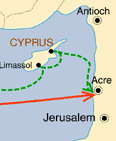![]() Richard
the Lionheart : the Crusader King
Richard
the Lionheart : the Crusader King
![Medal of Richard 'the Lionheart' by J.Dassio (1721). [Yorkshire Museum, York]](images/richard.gif) Richard
sailed from Marseilles for the Holy Land in August 1189 stopping at Messina in
Sicily on the way. His sister Joan had been married to the late King William
II of Sicily and he wanted to recover her dowry and a legacy. Richard had to
press his claim with Tancred, the new king and occupied Messina in October
1190 before a treaty was made. Richard also agreed a treaty with his co-crusader,
King Philip Augustus of France, which included setting aside a commitment to
marry Philipís sister, Alice, so that he could marry Princess Berengaria of
Navarre.
Richard
sailed from Marseilles for the Holy Land in August 1189 stopping at Messina in
Sicily on the way. His sister Joan had been married to the late King William
II of Sicily and he wanted to recover her dowry and a legacy. Richard had to
press his claim with Tancred, the new king and occupied Messina in October
1190 before a treaty was made. Richard also agreed a treaty with his co-crusader,
King Philip Augustus of France, which included setting aside a commitment to
marry Philipís sister, Alice, so that he could marry Princess Berengaria of
Navarre.
 Richard left Sicily in April 1190 and
reached Cyprus which he conquered before marrying Berengaria in Limassol
cathedral. In June Richard and his forces arrived in the Holy Land and joined
the siege of Acre which fell to the Crusaders in July. Philip Augustus then
left the Crusade and Richard became its undisputed leader. However, in spite
of defeating Saladin, the Turkish sultan, in September 1191, Richard failed to
take Jerusalem.
Richard left Sicily in April 1190 and
reached Cyprus which he conquered before marrying Berengaria in Limassol
cathedral. In June Richard and his forces arrived in the Holy Land and joined
the siege of Acre which fell to the Crusaders in July. Philip Augustus then
left the Crusade and Richard became its undisputed leader. However, in spite
of defeating Saladin, the Turkish sultan, in September 1191, Richard failed to
take Jerusalem.
In April 1192 Richard heard that his brother John was plotting against him and had expelled his deputy William Longchamp from England. Richard came to an agreement with Saladin which allowed for an independent Latin kingdom on the coast and in October 1192 he left the Holy Land.
![Richard I imprisoned (left) and fatally injured at the castle of Chalus. Effigies regum Angliae [British Library]](images/lion.jpg) After hearing that the French king
was planning to ambush him Richard did not return via Marseilles, but
travelled up the Adriatic aiming at an overland route. He was wrecked off
Venice and got as far as Vienna where he was captured by Leopold, Duke of
Austria, a man he had insulted at the siege of Acre. In February 1193 Leopold
handed Richard over to the German Emperor, Henry VI, in return for a share in
the anticipated ransom.
After hearing that the French king
was planning to ambush him Richard did not return via Marseilles, but
travelled up the Adriatic aiming at an overland route. He was wrecked off
Venice and got as far as Vienna where he was captured by Leopold, Duke of
Austria, a man he had insulted at the siege of Acre. In February 1193 Leopold
handed Richard over to the German Emperor, Henry VI, in return for a share in
the anticipated ransom.
In February 1194 Richard was released at Mainz on payment of a ransom of 150,000 marks of silver (£100,000) which the Emperor used to conquer Sicily and bring Norman rule in the island to an end.
Richard returned briefly to England in March 1194 and defeated Prince Johnís conspiracy. He was recrowned in Winchester and appointed Hubert Walter, the Archbishop of Canterbury, to replace Longchamp as his deputy. Richard then departed for France to defend his Norman possessions against the French king.